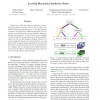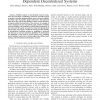135
click to vote
CVPR
2012
IEEE
13 years 2 months ago
2012
IEEE
Categories in multi-class data are often part of an underlying semantic taxonomy. Recent work in object classification has found interesting ways to use this taxonomy structure t...
121
click to vote
ICASSP
2011
IEEE
14 years 4 months ago
2011
IEEE
Building models of the structure in musical signals raises the question of how to evaluate and compare different modeling approaches. One possibility is to use the model to impute...
117
click to vote
ICASSP
2011
IEEE
14 years 4 months ago
2011
IEEE
Canonical distributed quantization schemes do not scale to large sensor networks due to the exponential decoder storage complexity that they entail. Prior efforts to tackle this i...
206
click to vote
SADM
2010
14 years 7 months ago
2010
: The k nearest neighbor classification (k-NN) is a very simple and popular method for classification. However, it suffers from a major drawback, it assumes constant local class po...
119
click to vote
JMLR
2010
14 years 7 months ago
2010
In this paper we learn a dissimilarity measure for categorical data, for effective classification of the data points. Each categorical feature (with values taken from a finite set...
127
click to vote
TKDE
2010
14 years 10 months ago
2010
This paper proposes a new problem, called superseding nearest neighbor search, on uncertain spatial databases, where each object is described by a multidimensional probability den...
114
Voted
VLDB
2002
ACM
15 years 1 days ago
2002
ACM
A continuous nearest neighbor query retrieves the nearest neighbor (NN) of every point on a line segment (e.g., "find all my nearest gas stations during my route from point s...
116
Voted
PRL
2002
15 years 1 days ago
2002
In this paper, a classification task on dissimilarity representations is considered. A traditional way to discriminate between objects represented by dissimilarities is the neares...
112
Voted
TROB
2008
15 years 9 days ago
2008
Abstract-- Stability analysis of decentralized control mechanisms for networked, coordinating systems has generally focused on specific controller implementations, such as nearest ...
105
Voted
PAMI
2008
15 years 10 days ago
2008
Abstract-Similarity searching often reduces to finding the k nearest neighbors to a query object. Finding the k nearest neighbors is achieved by applying either a depth-first or a ...


